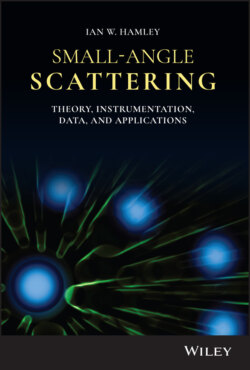Читать книгу Small-Angle Scattering - Ian W. Hamley - Страница 12
1.2 WAVENUMBER AND SCATTERING AMPLITUDE
ОглавлениеIn a SAS experiment, the intensity of scattered radiation (x‐rays or neutrons) is measured as a function of angle and is presented in terms of wavenumber q. This removes the dependence on wavelength λ which would change the scale in a plot against angle, i.e. SAS data taken at different wavelengths will superpose when plotted against q, this is useful for example on beamlines where data is measured at different wavelengths (this is more common with neutron beamlines). The wavenumber quantity is sometimes denoted Q although in this book q is used consistently. The difference between incident and diffracted wavevectors q = ks − ki and since , and the scattering angle is defined as 2θ (Figure 1.1), the magnitude of the wavevector is given by
(1.1)
Figure 1.1 Definition of wavevector q and scattering angle 2θ, related to the wavevectors of incident and scattered waves, ki and kf.
In some older texts, related quantities denoted s or S are used (these can correspond to q/2 or q/2π; the definition should be checked). The wavenumber q has SI units of nm−1, although Å−1 is commonly employed.
The amplitude of a plane wave scattered by an ensemble of N particles is given by
(1.2)
Here, the scattering factors aj are either the (q‐dependent) atomic scattering factors fj(q) (Section 4.4) for SAXS or the q‐independent neutron scattering lengths bj for SANS (Section 5.4).
For a continuous distribution of scattering density, Eq. (1.2) becomes
(1.3)
Here Δρ(r) is the excess scattering density above that of the background (usually solvent) scattering, which is a relative electron density in the case of SAXS or a neutron scattering length density (Eq. (5.11)) in the case of SANS.
